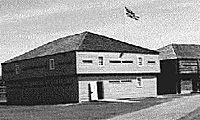The reconstruction of Forts Niagara and Erie could start with ruins and dilapidated buildings. The effort to rebuild Fort George, at Niagara-on-the-Lake, Ontario, had even less to work with. All that remained was a powder magazine which was then in use as a farmer's storage shed.
 Wooden blockhouse, Fort George
Wooden blockhouse, Fort George
Like Fort Erie, Fort George owed its origins to the river and Great Lakes. From 1765 there was a group of buildings on the Niagara River collectively known as Navy Hall, marking the eastern terminus of the communications corridor that Fort Erie came to defended at the western end.
Fort George itself was built between 1796 and 1799 to guard Navy Hall, sharing its logistical burden, and to protect the Niagara frontier in general, as the region's population grew with the genesis of Anglophone Canada.
But its history proved to be a short one. In May 1813, American warships and artillery, including some at Fort Niagara just across the river, pounded Fort George into ruins. This was the prelude to a massive invasion of Canada, which forced the British garrison out of what remained of the fort. The Americans occupied it through the summer and autumn, refortifying the site. However, the British recovered and drove the Americans back across the river, capturing Fort Niagara and ensuring the security of the Canadian Niagara frontier. After the war, the British army replaced Fort George with a new work, Fort Mississauga close to the east, and Butler's Barracks on the plain inland. The history of Fort George as a military post was over by the late 1820's, the fall into ruin already started.
Like the other two forts, it was rebuilt in the mid-twentieth century to its pre-1813 appearance, and was opened to the public in 1950. Today, Fort George National Historic Site is administered by Parks Canada. In size, it lays between the fairly small Fort Erie and the massive Niagara. However, it differs from both for its lack of masonry. Fort George is a work of earth and palisades laid out in a rough six-bastioned hexagons. It has nine buildings, all of wood, within its perimeter, plus an octagonal blockhouse in a redan just outside. Fort Erie, in contrast, has only two interior barracks, albeit of stone.
Yet there is an ambiance of frailty unlike either Forts Erie or Niagara. Fort Erie is a small, but sturdy-looking redoubt, while Fort Niagara is an imposing fortress. It does not take a military engineer to see that Fort George's wooden construction would (and did) made it very vulnerable to artillery.
Following the practice at Fort Erie, Fort George is staffed by knowledgeable, enthusiastic, costumed interpreters. Unlike it, the exhibits are in French as well as English. In addition, there is both a political correctness and a nationalistic cant generally not present at either of the other forts. The first is manifested in a noticeable stress on the class differences between British officers and enlisted men, reflected by the grossly unfair military justice system of the period. One interactive display asks visitors to guess the punishments for crimes of similar severity by officers and other ranks; invariably the officers' penalties consist of fines at mess and the scorn of comrades, whereas enlisted men tend to be flogged nearly to death. This does reflect the class-obsessed social structure of the time, but a little bit goes a long way, and the administrators of Fort George dwell on it a little too much.
The nationalism varies in subtlety and, to American eyes at least, can be somewhat amusing. For example, the fort contains a display of how seventeenth-century fortifications used open fields of fire, a deep ditch, and steep ramparts to thwart the efforts of attackers. The illustrations in the exhibit show neat ranks of stalwart British soldiers arrayed on their firing positions, decimating sorry-looking mobs of American rabble.
But once past the ideological agendas, Fort George offers informative and vivid views of the area's history, and life in the early 19th century British army. The guides are outstanding sources of information. American tourists brought up on the Rockets' Red Glare and a belief that Canadian history consists of nothing but hockey players are best advised to ask a few questions and be prepared to listen. They will get a fascinating lesson in history from a fresh perspective.
Niagara Frontier Touring the Restored Forts
-
Niagara Frontier: Introduction
Niagara Frontier: Fort Niagara
Niagara Frontier: Fort Erie
Niagara Frontier: Fort George
Niagara Frontier: Fort Mississauga
Niagara Frontier: Battlefield of Queenston Heights
Niagara Frontier: Getting There
Back to Cry Havoc #18 Table of Contents
Back to Cry Havoc List of Issues
Back to MagWeb Master Magazine List
© Copyright 1996 by David W. Tschanz.
This article appears in MagWeb (Magazine Web) on the Internet World Wide Web. Other military history articles and gaming articles are available at http://www.magweb.com